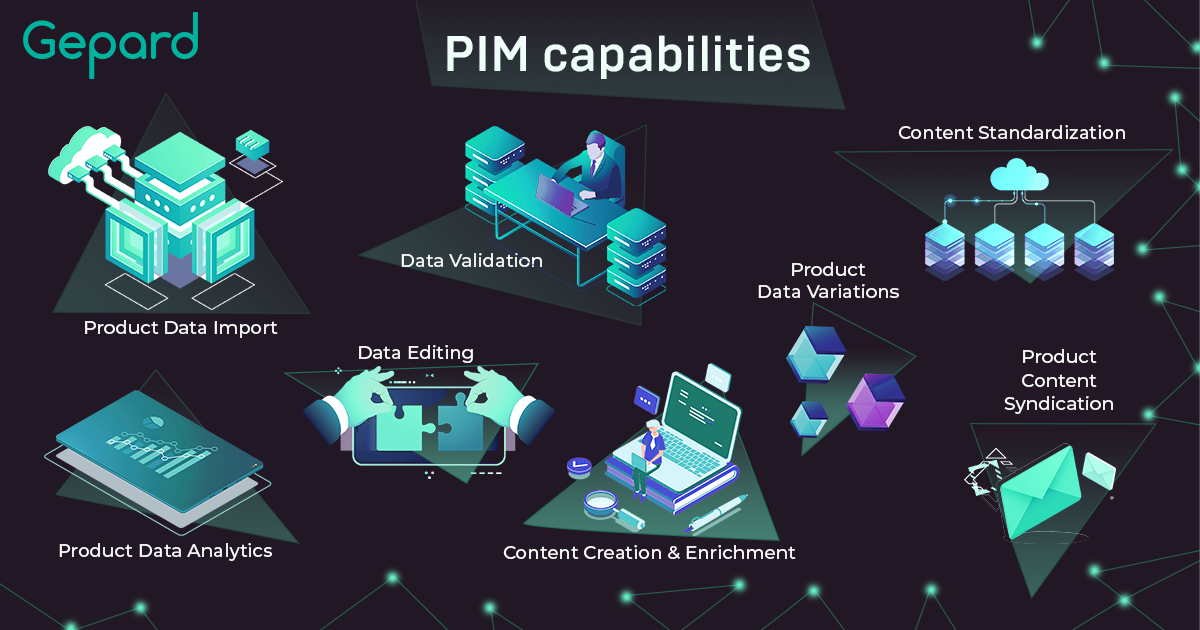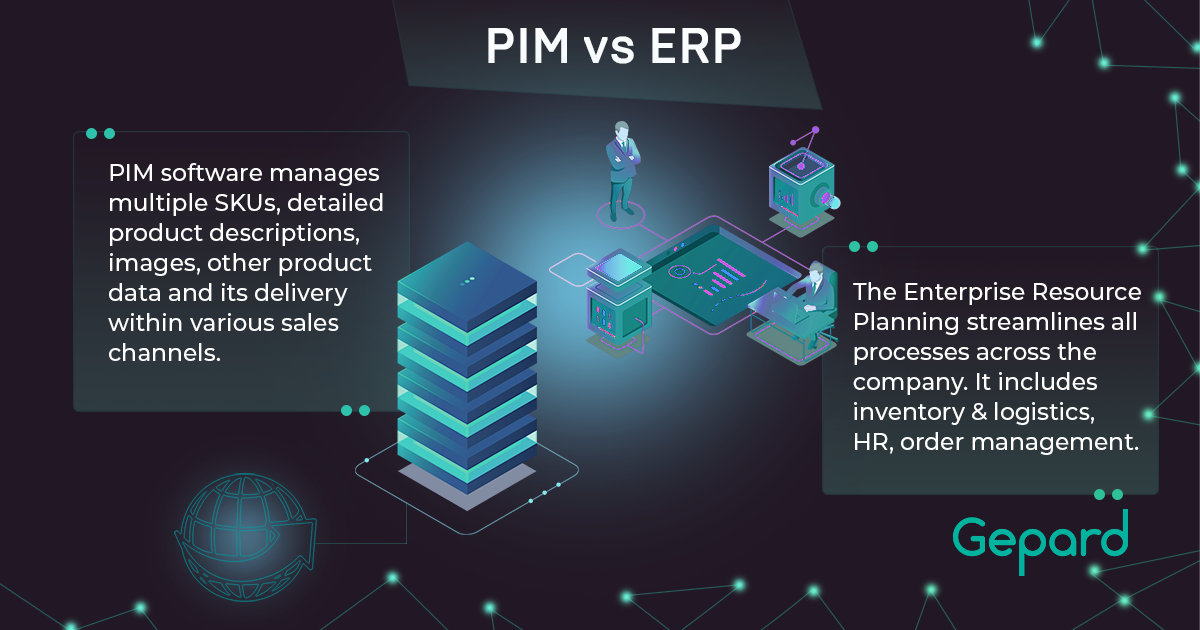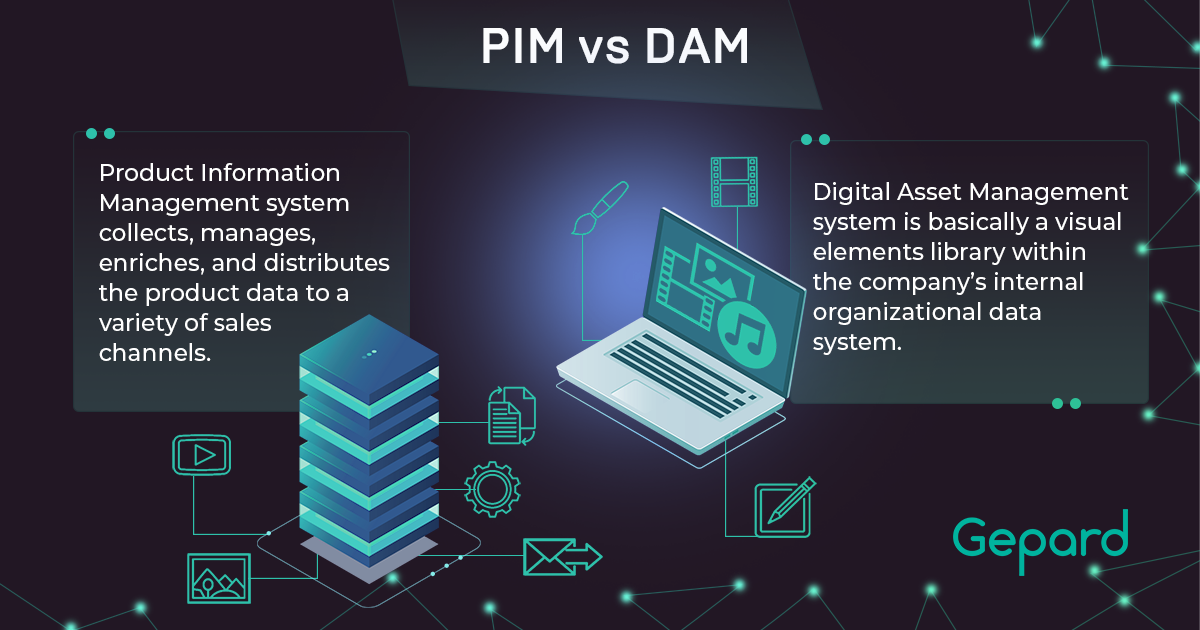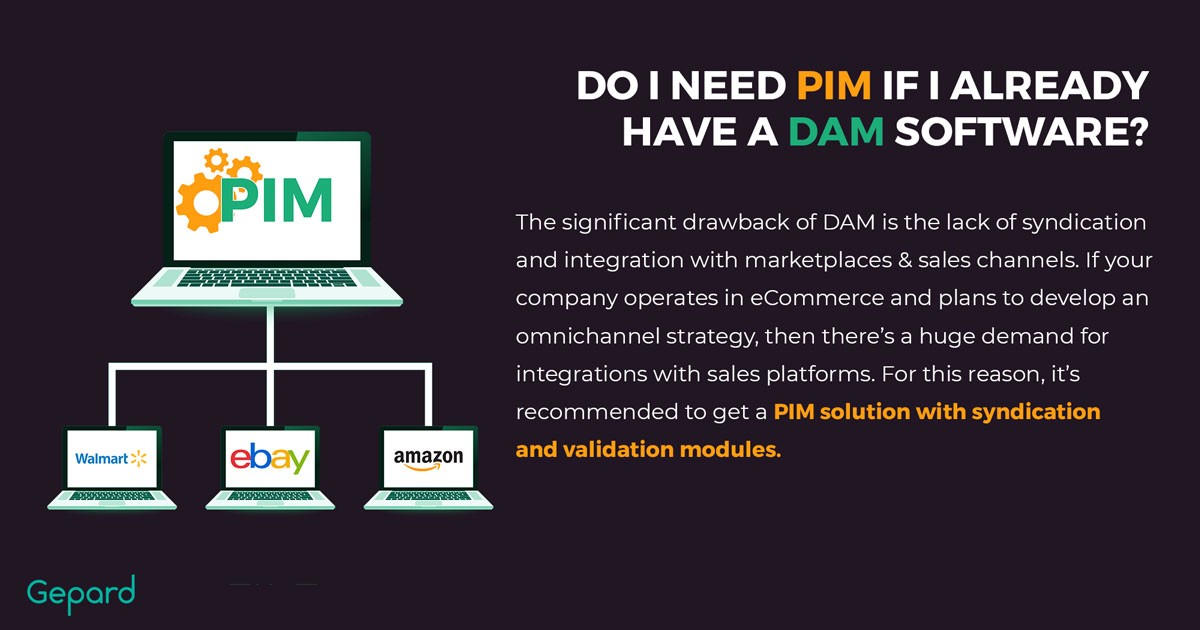Solutions Comparison: PIM vs DAM vs MDM vs ERP vs PXM
Data is the fuel and power of the modern business world. The more companies expand their horizons, the more information they have to handle. Technology solved this problem by offering numerous data management solutions, but still, it’s easy to get confused among the variety of options.
A plethora of solutions have been developed to process product information over the last few years. Large-scale MDM software and ERP systems are used for high-level enterprise management processes. PIM system, DAM software, and PXM solution work directly with the product databases.
In this article, you will find all the answers about the differences between ERP, MDM, DAM, PIM & PXM solutions that will help you to make the correct decisions on how to choose software tailored to your business.
Product Data Management Solutions
There are a certain number of software tools developed to satisfy eCommerce company needs. Some of them are general and organizational, others are more specific and product-oriented.
- MDM (Master Data Management) serves as a company’s database for all master data and is accessible to each employee.
- ERP (Enterprise Resource Planning) systems focus on the company’s resources and business process optimization.
- DAM (Digital Asset Management) software is a convenient and reliable source of the company’s media assets easily accessible by all its employees.
- PIM (Product Information Management) system is an irreplaceable tool for all kinds of product data management.
- PXM (Product Experience Management) software provides delivery of products at the right time into the right place, as well as creates mechanisms to keep customers satisfied, loyal, and willing to make further purchases in stores.
ERP, PIM and DAM integration create great opportunities for eCommerce growth. Product data management is supported by deeper and more specific solutions intended to provide product data to a customer. All these solutions are developed to enhance a company’s productivity and generate higher income.
Let’s review and compare the most popular data management tools, their main features, and use cases, to help you make a well-informed decision on the right solution for your business.
What Is Product Information Management Software?
Product Information Management is a system used as a central repository for gathering, enrichment, and management of a company’s product data, with the capabilities of data validation, standardization, synchronization, and distribution to various sales channels and eCommerce platforms.
What is product information management software for eCommerce retailers? PIM solution was initially designed to promote product data through various sales channels. The main purpose of PIM software is to manage the product content and optimize product pages to grow revenue and market share. Product information management best practices multiply businesses’ profits and save a great deal of time.

PIM capabilities
- Simple and immediate product data import through integration with internal & external data sources.
- Data editing in bulk to keep its consistency and save time.
- Product data analytics in real-time and with comprehensive dashboards.
- Data validation allows controlling the quality of the content based on certain rules defined by you.
- Product content creation, and enrichment.
- Keeping multiple product data variations for the same product.
- Content standardization to simplify the content exchange.
- Product content syndication to various eCommerce partners.
PIM Software Comparison 2024
eCommerce businesses work with large amounts of product information, to the point that using PIM for retail becomes not just advisable but unavoidable. The market for product information management solutions is steadily growing. Thus every eCommerce market player can find the right solution to cater to their business needs.
Here’s an extended PIM solution comparison in 2024, highlighting their main features for brands, manufacturers, and retailers.
| Feature | Gepard | Pimcore | Akeneo | Treopim(Atropim) |
| Bulk Import/Export | – automatically via an established connection (API/FTP) – manually by uploading files in supported formats (CSV, XLSX, XML, JSON) |
Yes | Yes in CSV/XLSX format | Via paid extension |
| Multimedia support | Images, media files, attachments, pdfs, etc | Images, hotspot images, PDFs, and videos | Demo version supports only a single image. However, the Enterprise version supports other formats | Demo version only supports images. Separate paid extensions are available that support other multimedia formats |
| Product Preview | Yes, via demo request | Yes | No | No |
| APIs | API-push is standard Import/Export through API/is configurable/might need development for a specific connection |
API is deprecated, but its data-hub is offered for web services | Yes, with good documentation. Product Access Manager (PAM) is offered as a separate system | Yes, but unstable at the moment |
| Mapping of products | Powerful AI mapping engine with flexible transformation rules support. There’s a team of taxonomists | Should be implemented as a separate function | Offered as an extension | Field mapping is possible, but it needs to be done manually |
| Roles | 4 standard roles and optionally new roles can be created via UI | Can be set up | Defining roles is possible | Can be set up |
| Data restriction | Possible according to role-based permissions settings | Possible according to roles | User level defines the data level access | Possible according to roles |
| Permission at field level | No, permissions are at the entity level | Yes | Not possible at field level | Yes |
| Flexible data model | Yes, new entities can be introduced within a tenant setup | Yes, relationships between entities can be defined | No | Yes, relationships between entities can be defined |
| Custom fields | Yes | Possible | Yes | Yes |
| Data quality and completeness | Data validation types:
– field type and input validation (i.e. text-text, numerical-numerical) |
Data validation and quality reports are provided to ensure data quality and completeness. Individual rules can be set up | A completeness score is provided and the rules can be set up according to the individual company | Data quality and completeness are not provided, but a paid extension is available |
| Configurable dashboard | Can be set up | Can be set up | No | Can be set up |
| Two-factor authentication (2FA) supported | Can be additionally set up | Yes | No, but a paid extension is available | No |
| Open source | License is required | Most features are available for free | Very limited in features. The Enterprise version provides the most common features | Most features are free in the demo, but some of them are not working |
| Technologies used | PHP 7.2-7.4, MongoDB 3.6-4.0, RabbitMQ, ElasticSearch | Javascript, PHP MySQL/Maria DB | PHP, HTML, CSS, Python, MySQL/ Maria DB | PHP, MySQL/Maria DB |
When To Choose PIM
A product information management solution is valuable for:
- Businesses that have a dynamic product assortment require constant updating and sharing across different retail platforms.
- Retail companies that want to develop an omnichannel sales strategy and get to market faster.
- Brands that need their product portfolio to be regularly updated according to the requirements and product taxonomy of the various marketplaces.
- Retailers who want to collect syndicated and verified product data from numerous brands and manufacturers easily and increase their sales.
- Businesses that want to set up seamless integrations with content providers and flawlessly enrich their product data, to provide their customers with large-scale and accurate product content.
Master Data Management Solution: Benefits Of The Large Scale
MDM, short for master data management, belongs to the structure of a company’s internal organizational data system. What master data management’s main functions are? It describes processes, keeps, accesses, and provides all the company’s data for various operations.
One of the most important master data management benefits is that it works across multiple domains of the organization. In fact, its infrastructure can be compared to a hub intended to source and distribute data among all the organization’s departments. Master data management tools create an accurate and consistent database instantly accessible to employees according to their access level.
MDM capabilities
- Enhanced data quality, uniformity, and consistency.
- Prevention of data duplication and/or inaccuracy.
- Automation of data processing mechanisms that save resources (time, money, workforce).
- Compliance with laws and policies related to data helps to avoid penalties and security breaches.
- Better business decision-making based on more accurate data analysis.
- More efficient collaboration between multiple departments.
PIM vs MDM: Main Differences
What is the main difference between PIM and MDM?
Master data management strategy is not focused on product data. However, the product-focused approach of PIM might involve the cooperation of various departments within the company and make their contribution valuable for product enrichment.
While large-scale MDM projects enhance the company’s internal data processes, more flexible and agile PIM mechanisms focus on the elaboration of marketing and sales solutions to raise the company’s profits.
MDM vs ERP: Main Differences
Their primary difference is their focus. MDM focuses on centralizing and governing the “master data” within an organization to ensure its accuracy, quality, and consistency, whereas ERP optimizes business processes across various functions like finance, HR, and supply chain.
While MDM aims to create a “single source of truth” by standardizing and cleansing data, ERP integrates these optimized processes into a cohesive system that supports overall organizational functions and decision-making.
The scope of MDM is more data-centric, dealing with critical data sets like customer information, suppliers, and finances, which are essential for high-level decision-making and multiple business processes. In contrast, ERP is concerned with broader operational efficiency and integration across departments.
Implementing MDM is often seen as a foundational step before ERP implementation. Clean and reliable data from MDM serves as the basis for ERP to function effectively, highlighting the complementary relationship between the two.
As a small conclusion of their difference, I can say that MDM addresses the challenge of data inconsistency across departments by offering a centralized repository and data management tools, while ERP tackles the complexity of integrating various business processes and functions into a unified system for seamless operations.
ERP System: Its Purpose And Capabilities
The name ‘ERP’ implies the enterprise resource planning software, which is essentially the backbone of every internal organizational data system. Enterprise resource planning’s definition lies in its name: the purpose of the solution is to integrate and manage key business functions and processes of the organization. These functions may include subjects from inventory and logistics to HR, from order management to CRM. Enterprise resource planning’s importance is in streamlining processes and data across the entire company, and data sharing among all the employees.
ERP capabilities:
- Integration of all the enterprise’s data that results in better analytics and business intelligence.
- Automation of routine operations that reduce operational costs and human error frequency.
- Mobile functionality that provides remote access to the data.
- Adjustable scalability + possibility to add/remove modules of the system.
- Comprehensive reporting.
Any enterprise resource planning system is implemented to structure and optimize business processes, including those related to marketing and sales. Prepared by the ERP system, raw product information can be further processed and enriched by more sophisticated PIM software tools in order to reach marketing and sales goals. While the ERP system controls stock or assigns deliveries, the PIM software manages multiple SKUs, detailed product descriptions, and their delivery within various sales channels. These two engines effectively complement each other while executing tasks they had been initially designed to do.

Digital Asset Management: A Brief Overview
DAM, or digital asset management software, is basically a visual elements library within the company’s internal organizational data system that preserves all kinds of content for internal and external purposes. In other words, the digital asset management system is the most comprehensive, up-to-date, accessible, and secure storage of digital files related to your products, including documents, presentations, audio, video, meta information, etc. (and they’re not necessarily directly product-related). One of the major benefits of digital asset management software is that it helps all the company’s employees take advantage of existing digital assets.
When to Choose DAM
- A digital asset management platform is beneficial for
- Companies with large amounts of digital assets that need to be stored in one centralized place.
- Organizations that create their own digital content (video and photoshoots, high-quality graphics) and need a set of tools with multiple functions for content editing.
- Businesses with many departments and teams involved in digital content creation and management who need an enterprise digital management solution to access rich media in one single place.
- Companies with multiple teams that need to keep up with the single-brand business strategy.
- Organizations that are particularly focused on marketing strategies and branding rather than product data push to different eCommerce platforms and sales channels.

The Difference Between PIM And DAM
It’s easy to get lost in a wide range of data organization solutions for enterprises. Business owners and stakeholders can get stuck when choosing the right option, wondering if they can implement PIM and DAM simultaneously or integrate product information management into their already existing DAM software. Let’s examine closely the difference between PIM and DAM.
Type of information:
Product information management is mostly focused on product information, while DAM enables you to work closely with the digital assets of your business: graphics, videos, company logos, and large amounts of other digital content.
Main goal:
The product information management system aims to establish product consistency, high quality, and verified & standardized product information that can be regularly updated with an opportunity to integrate with multiple online and offline sales channels and enable flawless data push to different eCommerce platforms.
DAM is focused on the digital resources of the enterprise, giving vast opportunities for editing by different business teams. Its broad capacities allow its users to handle large amounts of digital data. This is especially valuable for those who want to manage their own visual assets (high-quality videos, in-house photoshoots that require editing, and similar types of information).
Data transformation capabilities
DAM users can benefit from a wide range of functions and flows for digital content management. Namely, It’s a solution for storing and editing rich media files, where different teams can participate in content editing. While DAM offers many options for visual asset management, it does not allow a user to syndicate data (synchronize it with different sales channels and marketplaces).
It’s a significant drawback for businesses that sell many products and want to do it on multiple platforms. Yet, DAM can satisfy companies that require minimum data export processes. With that being said, it’s not possible to push data from DAM to retail platforms, webshops, and other points of sales.
A PIM solution has fewer features for managing specifically digital multimedia and focuses more on managing product data and establishing its consistency within the enterprise. It ensures that product data is stored at one central location, validated, and updated on time. Then the data can be seamlessly integrated with various sales channels and easily pushed to marketplaces while being adjusted to retailers’ specific requirements and data structure. With the help of this system, product content is streamlined across multiple platforms, enabling businesses to build an efficient omnichannel strategy.
Target Audience:
The benefits of digital asset management are especially noticeable in construction and real estate companies, higher educational institutions (colleges and universities), manufacturing, agencies, technology industries, and especially eCommerce and retail. These are the spheres where there is a lot of work related to digital data collection and management, and that’s where digital asset management tools facilitate the creative data-related processes (extensive boards for teams, digital assets editing, and more).
When it comes to the PIM system, it is especially beneficial for retail industries: global brands and manufacturers, wholesalers and retailers, and distributors. Businesses that work with middle-sized, big, or extremely large amounts of products need product information management software for sure to solve the biggest challenges of online retail: pushing high-quality and validated product data to multiple sales platforms, meeting their data requirements, establishing product taxonomy structure and providing customers with truthful, complete and attractive product information.
Product Experience Management: Inevitable Tool of eCommerce Strategy
PXM, i.e. product experience management, is the software that gathers and produces product content to engage customers and trigger buying decisions. What is product experience management at its core? Essentially, its purpose is to stage the unique product experience your customers would enjoy. Accordingly, PXM involves standardization, optimization, distribution, and customization of product data in all the channels the company employs.
PXM capabilities:
- Most accurate possible information on every product.
- Consistency in product data across different channels.
- Tailored content for different target audiences and sales channels.
- Product content in-depth analytics.
- Variety of product enrichment strategies.
- Automation and optimization with the application of AI and ML.
- Easy import and export of product data.
How is product experience management software different from PIM?
Both systems are aimed at enriching the customer’s experience. Companies implement PIM to process and standardize product data + syndicate it to various channels in the quickest and most efficient way. PXM concentrates on the customer’s product experience by personalization, contextualization, and enrichment of the relevant product data.
PIM system is the source of product data that enables PXM. Thus, PXM can be a part of the PIM solution. PIM system is WHAT business uses to describe products, whereas PXM is HOW you orchestrate customers’ product selection and buying experience. Product management user experience is becoming even more important as consumers are becoming more and more demanding, and their needs – are more specific. This is probably the key takeaway from current public discussions related to PXM and PIM features.

Data Management Tools FAQ
Who Needs ERP System?
Many industries need an ERP solution for effective enterprise management. For any business that requires financial management, supply chain, operations management, project management, human resources, customer relationship management, and especially automation of business processes, having an ERP system is beneficial.
Can PXM Be A Part Of The PIM Solution?
A simple and flexible PIM solution provides the data that fuels a product experience management solution. Basically, it means that PXM can be a part of the product information management solution, especially considering the fact that the buyers are becoming more demanding with the product content, and businesses are focusing not just on WHAT data they provide, but also on HOW it is presented.
What Is A Digital Asset?
Digital assets are any company or individual-owned digital materials, containing text data, graphics, video, audio materials, and other rich media. Digital assets’ definition is not limited to videos or photos and can include any other files in digital formats, such as datasheets, presentations, and more.
Do I Need PIM If I Already Have A DAM Software?
The significant drawback of digital asset management is the lack of syndication and DAM integrations with marketplaces and sales channels. If your company operates in eCommerce and plans to develop an omnichannel strategy, then there’s a huge demand for integrations with sales platforms. For this purpose, even if you already have a DAM solution, it’s advisable to implement product information management software with syndication and validation modules to be able to easily integrate product information with numerous marketplaces, verify and standardize the data, and adjust it to the requirements and taxonomy of various sales platforms.

Gepard PIM: Enhanced Product Data for Your Business
Pursuing business goals becomes much easier when all of your data assets are well organized and aligned with your business strategies. The market offers a lot of data management solutions and each of them is aimed at enriching your buyer’s experience.
You already know the differences between PIM, MDM, PXM, and DAM systems, their main features, and their advantages and downsides. Yet, at the core of any efficient business, there is a product information management system, incorporated to enhance the sales potential, business visibility, and shopping experience.
Gepard’s PIM functionality allows brands to enrich their product content, syndicate and validate it, modify the data in accordance with the ever-changing requirements of marketplaces and automatically push enriched product content to multiple sales platforms. Retailers can get flawless automated data collection from brands and manufacturers, to guarantee the highest quality of product content, improve customer experience and outpace competitors.
Reach out to our dedicated specialists to learn more about our product information management solution, its main features, and integrations, and discuss what value product information management can bring to your business.



